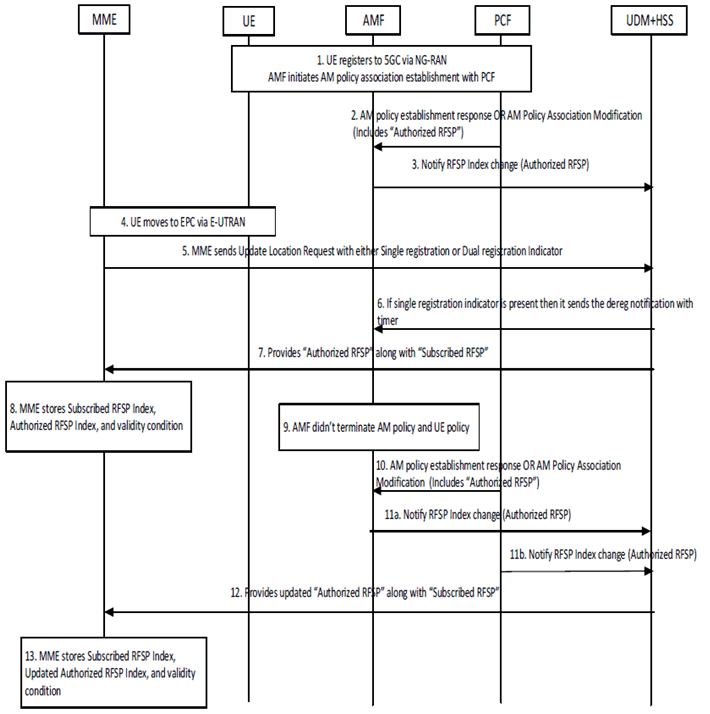Content for TR 23.700-89 Word version: 18.0.0
6.7 Solution #7: Provide updated RFSP when UE is already moved to EPS without N26 interface
6.7.1 Description
6.7.2 Procedures
6.7.3 Impacts on services, entities and interfaces
...
...
6.7 Solution #7: Provide updated RFSP when UE is already moved to EPS without N26 interface p. 22
6.7.1 Description p. 22
This paper reuse the concept of solution 1 to implement AM policy association maintenance timer to send any further updated RFSP to MME when UE is already moved to EPS. It retains the concept of solution 2 to send the RFSP to MME via UDM+HSS.
When UE moves to EPS, MME registers its address in UDM+HSS and then UDM+HSS shall maintain UE's 5G registration state temporarily for some duration i.e. AM Policy Association maintenance timer if the UE is in single registration mode. It provides this timer while sending deregistration notification to AMF so that both AMF and UDM+HSS will be in sync in holding this temporary registration state for the UE.
During this time period based on some trigger, the PCF may update UE's RFSP index in order to direct the UE back from EPC to 5GC. The update RFSP index is deliver to the AMF. AMF then notifies to HSS+UDM and then UDM+HSS will notify to MME.
6.7.2 Procedures p. 23

The detailed procedure is described in Figure 6.7.2-1.
Step 1.
The UE registers to 5GC via NG-RAN. AMF establishes AM Policy association with PCF as in clause 4.16.1.2 of TS 23.502.
Step 2.
The PCF decides to adjust the RFSP index to direct the UE from 5G to 4G. The PCF decision could be based on various inputs. For example:
Step 3.
- Based on various analytics and prediction result from NWDAF (e.g. network congestion in 5G).
- According to the request from AF.
AMF notifies the UDM on the "Authorized RFSP" received from PCF. If the UDM and HSS are deployed separately then the UDM further notifies the "Authorized RFSP" to the HSS. In a combined UDM+HSS deployment this step (step 5b in Figure 6.2.2-1) is not needed or handled in implementation specific way.
Step 4.
UE moves to EPS via E-UTRAN.
Step 5.
The MME sends the ULR with single registration or dual registration mode indication and register its address in UDM+HSS.
Step 6.
The UDM+HSS starts the "AM Policy Association Timer" and maintain the UE's 5G registration state for this duration if the UE is in single registration mode and provides this timer in the Nudm_UECM_DeregistrationNotification to AMF.
Step 7.
The UDM+HSS provides the Authorized RFSP to MME.
Step 8.
The MME stores and use the received "Authorized RFSP Index" from UDM+HSS.
Step 9.
The AMF didn't clear the UE context for the time duration received from UDM+HSS.
Step 10.
Based on some trigger, PCF decides to update the Authorized RFSP and notify to the AMF according to current description in TS 23.503.
Step 11.
The AMF notifies the Authorized RFSP to UDM+HSS
Step 12.
The UDM+HSS provides the Authorized RFSP to MME.
Step 13.
The MME updates the received "Authorized RFSP" and use it.
6.7.3 Impacts on services, entities and interfaces p. 24
This solution may have the following impacts to existing entities and interfaces:
AMF:
-
When a UE is moving from 5GS to EPS, and HSS/UDM invokes Nudm_
UECM_ to notify the AMF associated with 3GPP access with reason as 5GS to EPS Mobility, the AMF should maintain the UE's registration context for the received time period.DeregistrationNotification
- UDM+HSS should maintain the UE's 5G registration state temporarily for some duration. Also it will provide this time period to AMF while sending deregistration notification.